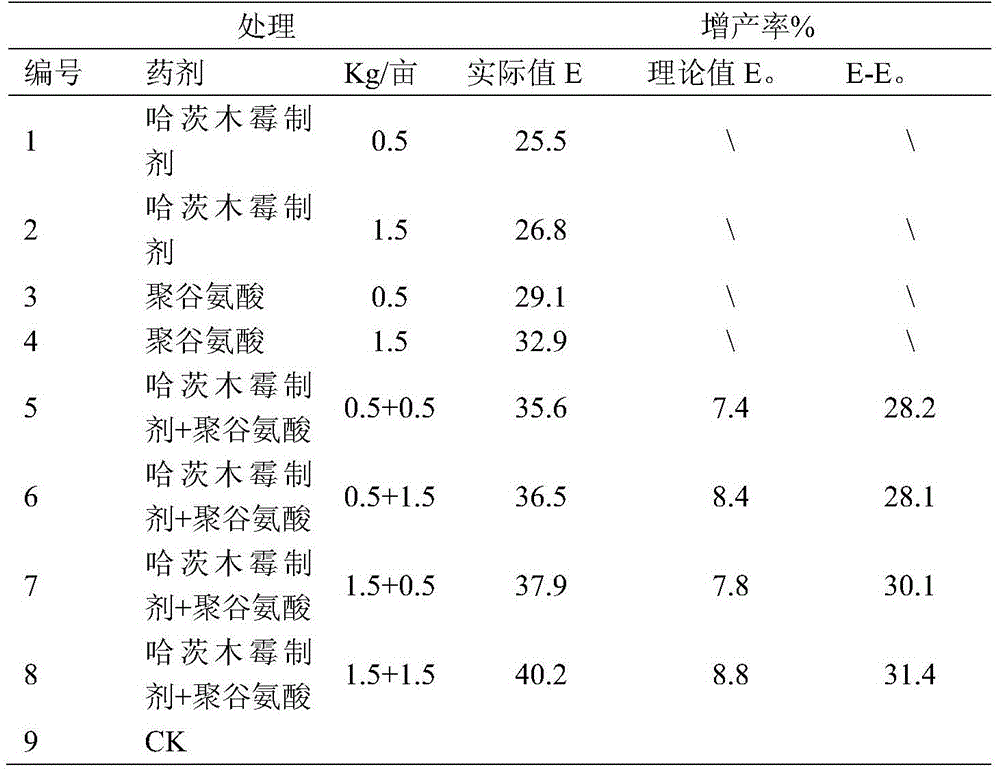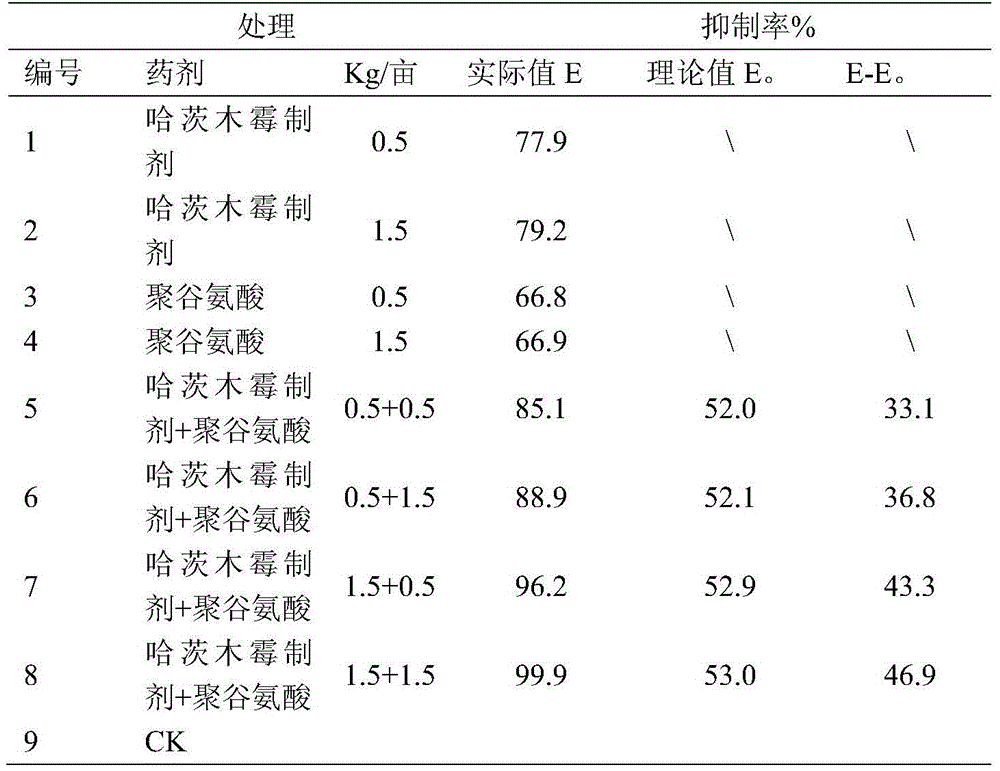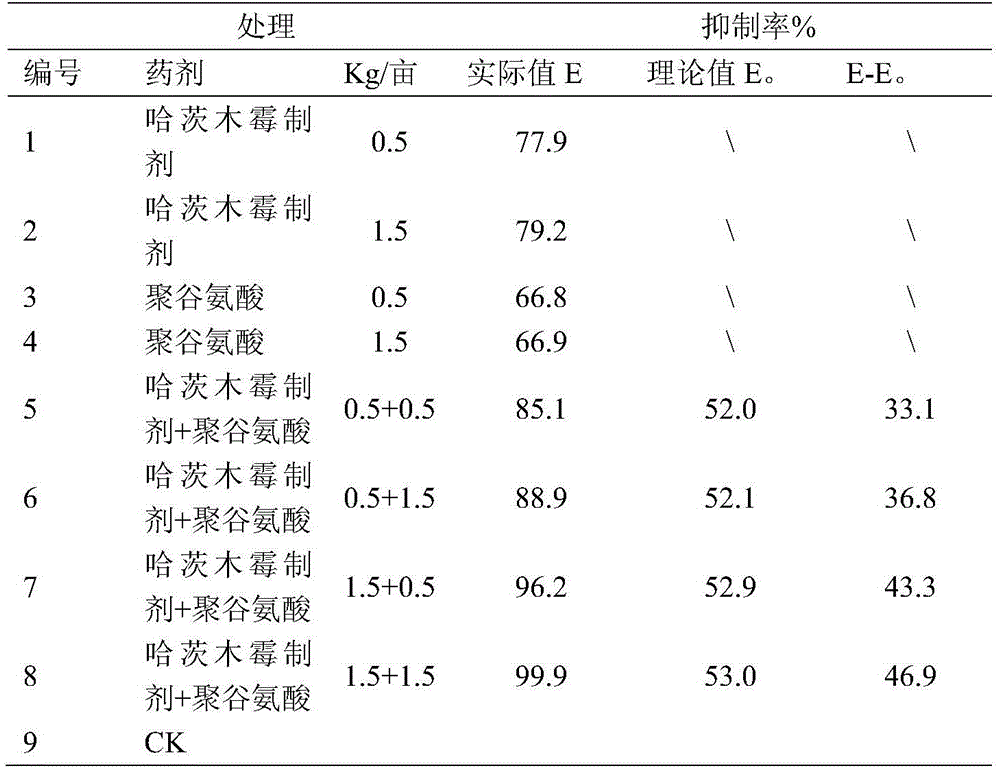Trichoderma harzianum and polyglutamic acid compounded microbial agent and application thereof
The technology of polyglutamic acid and inoculum is applied in the field of inoculum compounded by Trichoderma harzianum and polyglutamic acid, which can solve the problems of polluting groundwater resources, increasing the use of pesticides, enhancing the resistance of disease pathogens, etc. Good control effect, improve crop quality, improve soil effect
- Summary
- Abstract
- Description
- Claims
- Application Information
AI Technical Summary
Problems solved by technology
Method used
Image
Examples
Embodiment 1
[0033] Example 1 Experiment of increasing yield of cabbage
[0034] Before planting the cabbage, deep turn the soil, and evenly apply the above-mentioned formulations, apply the same weight of nitrogen fertilizer for the control (CK), and calculate the yield increase rate of the cabbage at harvest;
[0035] Yield increase rate of cabbage%: 100X (treatment per mu yield-control yield per mu) / control yield per mu;
[0036] According to the formula of Colby method (1966), the yield increase rate is calculated and compared with the measured yield increase rate, which is a simple and effective way to evaluate the combined effect of the mixture. The calculation formula is:
[0037] E=X 1 ×X 2 …×X n / 100 (n-1)
[0038] E is the theoretical synergy of the mixed agent; n is the number of mixed agents; X 1 Indicates the increase in yield after the application of the first agent; X 2 Indicates the increase in production rate after applying the second medicament; X n Indicates the increase in yield...
Embodiment 2
[0042] Example 2 Anti-Fusarium Wilt Test
[0043] Select the test field where cotton fusarium wilt often occurs. Before planting the cotton, deep turn the soil and evenly apply the fertilizer with the above content. The control (CK) is the blank control. The cotton grows to 8-9 leaves, and the cotton fusarium wilt is calculated. Incidence rate
[0044] Inhibition rate of cotton fusarium wilt %: 100X (the number of cotton fusarium wilt diseased plants in the control area-the number of cotton fusarium wilt diseased plants in the treatment area) / the number of cotton fusarium wilt diseased plants in the control area;
[0045] According to the Colby method (1966) formula, the inhibition rate is calculated and compared with the measured inhibition rate, which is a simple and effective way to evaluate the combined effect of the mixture. The calculation formula is:
[0046] E=X 1 ×X 2 …×X n / 100 (n-1)
[0047] E is the theoretical inhibition rate of the mixed agent; n is the number of mixed ...
Embodiment 3
[0051] Example 3 Anti-Bacterial Wilt Test
[0052] Select the test field where tomato bacterial wilt often occurs. Before planting tomatoes, turn the land deeply and evenly apply the above-mentioned fertilizer. The control (CK) is the blank control. The tomato grows to 8-9 leaves, and the tomato bacterial wilt is calculated Incidence rate
[0053] Inhibition rate of tomato bacterial wilt %: 100X (number of tomato bacterial wilt diseased plants in the control area-number of tomato bacterial wilt diseased plants in the treatment area) / number of tomato bacterial wilt diseased plants in the control area;
[0054] According to the Colby method (1966) formula, the inhibition rate is calculated and compared with the measured inhibition rate, which is a simple and effective way to evaluate the combined effect of the mixture. The calculation formula is:
[0055] E=X 1 ×X 2 …×X n / 100 (n-1)
[0056] E is the theoretical inhibition rate of the mixed agent; n is the number of mixed agents; X 1 I...
PUM
 Login to View More
Login to View More Abstract
Description
Claims
Application Information
 Login to View More
Login to View More - R&D
- Intellectual Property
- Life Sciences
- Materials
- Tech Scout
- Unparalleled Data Quality
- Higher Quality Content
- 60% Fewer Hallucinations
Browse by: Latest US Patents, China's latest patents, Technical Efficacy Thesaurus, Application Domain, Technology Topic, Popular Technical Reports.
© 2025 PatSnap. All rights reserved.Legal|Privacy policy|Modern Slavery Act Transparency Statement|Sitemap|About US| Contact US: help@patsnap.com



